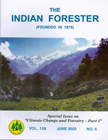Carbon Sequestration Through Community Based Forest Management - a Case Study from Sambalpur Forest Division , Orissa
DOI:
https://doi.org/10.36808/if/2003/v129i6/2338Abstract
The worldwide concern over global warming led to the formation of United Nations Framework Convention on Climate Change (UNFCCC) in 1992 to deal with GHG emissions. As per the Kyoto protocol of 1997 , the industrialized countries are expected to reduce the GHG emissions by 5.5% by 2008-12 over 1990 levels. Such countries are expected to buy carbon credits from developing countries under the Clean Development Mechanism (CDM). Global negotiations are on for operationalisation of the CDM mechanism. Afforestation and reforestation have already been included under CDM , and forest conservation activities are also likely to be considered under adaptation measures. A study was carried out to estimate the creation of carbon sinks and sequestration achieved in community-protected forests of Sambalpur Forest Division , Orissa. The results have shown that 1.53 to 3.01 tonnes of carbon is being sequestered per ha per year with only protection , which can be enhanced through proper implementation of the management prescriptions. Enormous opportunities exist to sequester carbon and to mitigate climate change patterns through regeneration in India's forests.Downloads
Download data is not yet available.
Downloads
Published
2003-06-01
How to Cite
Gera, M., Bisht, N. S., & Gera, N. (2003). Carbon Sequestration Through Community Based Forest Management - a Case Study from Sambalpur Forest Division , Orissa. Indian Forester, 129(6), 735–740. https://doi.org/10.36808/if/2003/v129i6/2338
Issue
Section
Articles
License
Unless otherwise stated, copyright or similar rights in all materials presented on the site, including graphical images, are owned by Indian Forester.





